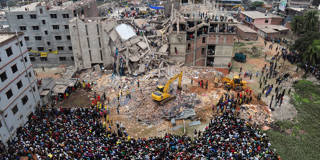Ten years ago, the collapse of the Rana Plaza factory complex in Bangladesh claimed the lives of 1,134 garment workers. In the years since, little has been done to make working conditions safer or address the underlying exploitation that enabled the disaster’s devastating human toll.
CAMBRIDGE – It has been ten years since an eight-story commercial building housing several textile factories on the outskirts of Dhaka, Bangladesh, collapsed on April 24, 2013. The collapse of Rana Plaza claimed the lives of 1,134 people and severely injured 2,000 more, most of them women.
It was the deadliest industrial disaster since the 1984 gas leak that killed more than 3,000 people in Bhopal, India, and the worst accident in the modern history of the textile industry. Thousands of workers were trapped beneath the rubble for several days, with many succumbing to hunger and dehydration while others resorted to drinking their own urine to survive.
The deaths were predictable and preventable. The building was constructed atop a filled-in pond using substandard materials, rendering it unable to support the weight of heavy machinery. The upper four floors were added illegally, further exacerbating its structural issues. Cracks in the building’s walls were seen in the days before the collapse, leading to the evacuation of some floors. But the building’s owner, Sohel Rana, insisted on business as usual. Under pressure from buyers to meet delivery targets, Rana threatened to withhold workers’ wages (roughly $38 per month) if they failed to report to work. For those who did, his building proved to be a death trap, collapsing in under 90 seconds.

CAMBRIDGE – It has been ten years since an eight-story commercial building housing several textile factories on the outskirts of Dhaka, Bangladesh, collapsed on April 24, 2013. The collapse of Rana Plaza claimed the lives of 1,134 people and severely injured 2,000 more, most of them women.
It was the deadliest industrial disaster since the 1984 gas leak that killed more than 3,000 people in Bhopal, India, and the worst accident in the modern history of the textile industry. Thousands of workers were trapped beneath the rubble for several days, with many succumbing to hunger and dehydration while others resorted to drinking their own urine to survive.
The deaths were predictable and preventable. The building was constructed atop a filled-in pond using substandard materials, rendering it unable to support the weight of heavy machinery. The upper four floors were added illegally, further exacerbating its structural issues. Cracks in the building’s walls were seen in the days before the collapse, leading to the evacuation of some floors. But the building’s owner, Sohel Rana, insisted on business as usual. Under pressure from buyers to meet delivery targets, Rana threatened to withhold workers’ wages (roughly $38 per month) if they failed to report to work. For those who did, his building proved to be a death trap, collapsing in under 90 seconds.